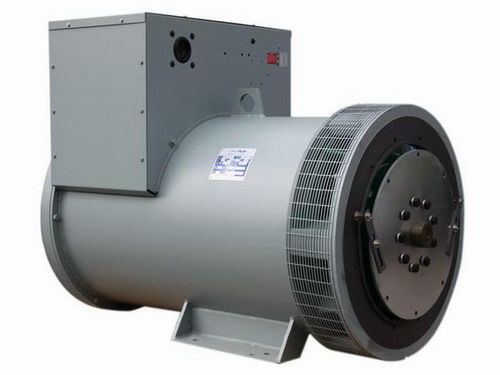MX generators are suitable for paralleling as full damping winding. But, before paralleling, each unit of generator should be started up, operated and adjusted.

1 . Additional paralleling circuitry
a. Voltage regulator-paralleling provisions
b. Paralleling current transformer(s)
c. Paralleling provisions on governor controls
d. Switchgear
2. The voltage and frequency must be the same for all sets with voltages in phase.
3. The generators must have the same phase sequence rotation.
4. The voltage regulation characteristics of the individual generators should be similar.
5. The driving engines should have the same speed regulation characteristics and the governors should be adjusted to give the same speed regulation.
When two identical generators are operating together in parallel and an unbalance occurs in field excitation, circulating currents begin to flow between the generators. This current will appear as a lagging power factor or inductive load to the highly excited generator, and as a leading power factor or capacitive load to the generator with the lower field current. This is known as the reactive circulating current, and there are two controlling methods in parallel operation:
1. Reactive droop compensation (formerly known as parallel droop compensation) - the bus voltage droops or decreases as the reactive lagging power factor load is increased. Then the output current and power of generator decreases, thus reactive power tends to balance.
2. Reactive differential compensation (formerly known as cross current compensation) - the reactive differential compensation circuit allows parallel generators to share reactive loads with no decrease or no droop in generator voltage, The circuit must meet the following criteria:
a. All secondary circuit of current transformers for generators being paralleled must be included into interconnection loop.
b. When different size generators are paralleled, all paralleling current transformers must have the same or proportional ratios that give approximately the same secondary current.
c. Reactive differential compensation cannot be used when paralleling with the utility power. There is no limit, however, in the number of generators that can be included in this type of circuit.
The paralleling with the utility power has different wiring circuitry, means and program, consult with manufacturer if need assistance.
Solid state electronic control devices which utilize thyristors or SCR firing circuits (such as variable frequency induction motor controls, precision motor speed controls, no-break powered battery chargers, etc.) can introduce high frequency harmonics which adversely affect or destroy the normal waveform of the generator. This creates additional heat in the generator stator and rotor and can cause overheating.
These devices can and do present problems to non-utility power generating equipment or any limited power bus system. The problems which can occur are not limited to the generator itself, but can effect the solid state control device, the equipment it controls, other associated loads, monitoring devices, or a number of combinations over the entire system.
MAGNAMAXDVR generators can supply power to thyristor or SCR loads when properly applied. When SCR loads are more than 25% of the total load, select the generator based on the 800C R/R rating. The standard voltage regulator is PMG powered and senses 3 phase RMS voltages for maximum stability against severely distorted wave forms. SCR type applications such as cranes, shovels, etc., require special consideration of the generator insulation system due to greater dielectric stress and severe environmental conditions. Please contact to Marathon Electric for application assistance.

Symptom: Generator Produces No Voltage or Residual Voltage | |
Regulator Fuse Blown | Check fuses with an ohmmeter. Replace bad fuse, Refer to regulator manual. |
Voltmeter Off | Check to be sure meter phase selector switch is not in the off position. |
Incorrect Connections | Verify generator connections (refer to drawings supplied with generator set or principle diagram). |
Defective Connections/Wiring | Inspect all wiring for grounds, open circuits, and short circuits. |
Defective Voltmeter | Verify proper operation of panel meter with another meter that is known to be accurate. |
No Regulator Input | Measure voltage at regulator input (PMG output). |
Defective Diodes, Surge Suppressor Generator Windings | Test generator with constant excitation (12 volt or battery test). |
Voltage Regulator Protective Shutdown Circuits are Operating | Correct problem and adjust regulator. Refer to regulator manual. |
Voltage Regulator Inoperative | Adjust or replace regulator. Refer to regulator manual. |
Symptom: Generator Produces Low Voltage - No Load | |
Under speed operation | Check speed using tachometers and/or frequency meters. |
Defective Voltmeter | Disconnect F1 and F2 leads at the voltage regulator. If voltage goes down, continue to next step. If voltage does not change, refer to Troubleshooting for symptoms of “No Voltage – Residual Voltage”. |
Incorrect Generator Connections | Verify generator connections (refer to drawings supplied with generator set). |
Defective Connections/Wiring | Inspect all wiring for grounds, open circuits, short circuits, loose connections, and dirty connections. |
Regulator Adjustments | Adjust regulator (refer to regulator manual). Check exciter field volts. |
Defective Diodes, Surge Suppressor, Generator Windings | Test generator with constant excitation (12 volt or battery test). |
Symptom: Generator Produces Low Voltage When Load Is Applied | |
Overload | Measure amps and verify that the load does not exceed the nameplate rating of the generator. |
Overload - Defective Ammeter | Verify operation of ammeter by using a separate meter that is known to be accurate. |
Droop Circuit
| If the generator set is equipped for paralleling, some voltage droop is normal as load increases (refer to the regulator instruction manual). |
Line drop | The sensing point far away from the measuring point of voltage meter, it may has some voltage drop on the longer line. |
Symptom: Generator Produces High Voltage | |
Defective Voltmeter | Verify operation of panel meter with another meter that is known to be accurate. |
Incorrect Operating Speed | Verify speed with tachometer or frequency meter. |
Incorrect Connections | Verify generator connections. |
Defective Connections/Wiring | Inspect all wiring for grounds, open circuits, and short circuits. |
Regulator Adjustments | Adjust regulator (refer to regulator manual). |
Diode Polarity Incorrect | Check diodes: verify proper diodes are installed and polarity is correct. |
Voltage Regulator Not Operating Properly | Adjust or replace regulator (refer to regulator instruction manual). |
Symptom: Generator Voltage Is Fluctuating | |
Incorrect Speed | Verify speed with tachometer or frequency meter. |
Unstable Speed | Verify governor stability. |
Voltage Regulator Stability | Adjust regulator stability (refer to regulator manual). |
Defective/Loose Connections | Inspect all wiring for loose or dirty connections. |
Defective Diodes, Surge Suppressor, or Generator Windings | Test generator with constant excitation (12 volt battery test). |
Remote Voltage Adjust (If used) | Check operation (refer to regulator manual). |
Defective Regulator | Replace regulator (refer to regulator manual). |
SCR load | Check the load situation, does it match. |
Copyright © Guangxi Dingbo Generator Set Manufacturing Co., Ltd. All Rights Reserved | Sitemap
Update cookies preferences